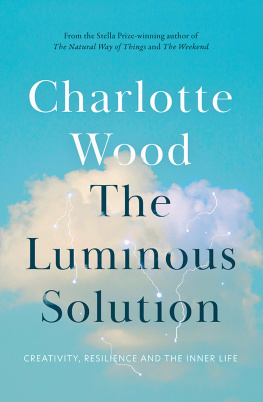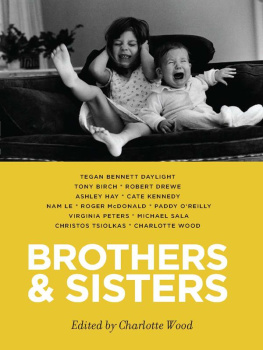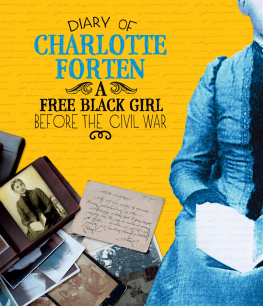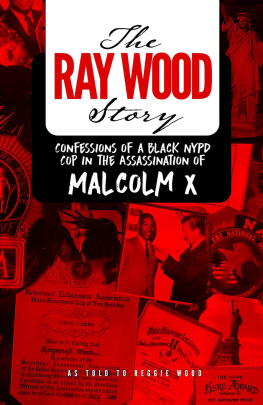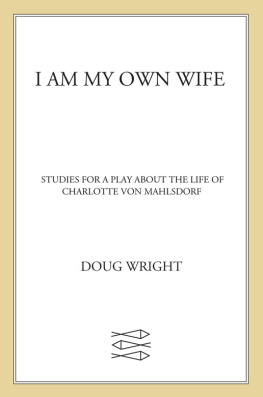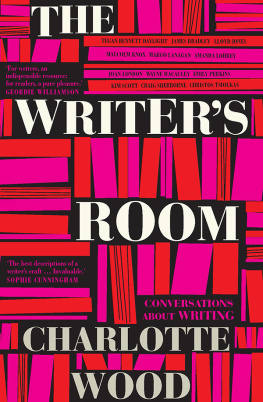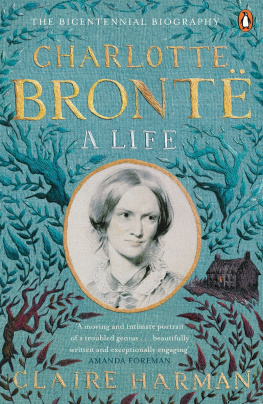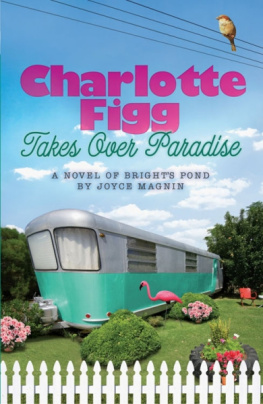Charlotte Wood - The Luminous Solution
Here you can read online Charlotte Wood - The Luminous Solution full text of the book (entire story) in english for free. Download pdf and epub, get meaning, cover and reviews about this ebook. year: 2021, publisher: Allen & Unwin, genre: Romance novel. Description of the work, (preface) as well as reviews are available. Best literature library LitArk.com created for fans of good reading and offers a wide selection of genres:
Romance novel
Science fiction
Adventure
Detective
Science
History
Home and family
Prose
Art
Politics
Computer
Non-fiction
Religion
Business
Children
Humor
Choose a favorite category and find really read worthwhile books. Enjoy immersion in the world of imagination, feel the emotions of the characters or learn something new for yourself, make an fascinating discovery.
- Book:The Luminous Solution
- Author:
- Publisher:Allen & Unwin
- Genre:
- Year:2021
- Rating:3 / 5
- Favourites:Add to favourites
- Your mark:
- 60
- 1
- 2
- 3
- 4
- 5
The Luminous Solution: summary, description and annotation
We offer to read an annotation, description, summary or preface (depends on what the author of the book "The Luminous Solution" wrote himself). If you haven't found the necessary information about the book — write in the comments, we will try to find it.
The Luminous Solution — read online for free the complete book (whole text) full work
Below is the text of the book, divided by pages. System saving the place of the last page read, allows you to conveniently read the book "The Luminous Solution" online for free, without having to search again every time where you left off. Put a bookmark, and you can go to the page where you finished reading at any time.
Font size:
Interval:
Bookmark:

Charlotte Wood is one of our finest and most chameleonic writers Woods novels are often uncomfortable explorations of Australian life: profound in their emotional scope superb storytelling.
Rebecca Starford, The Australian
Wood is an agonisingly gifted writer.
Marian Keyes
Ms Woods writing is direct and spare, yet capable of bursting with unexpected beauty.
The Economist
Wood joins the ranks of writers such as Nora Ephron, Penelope Lively and Elizabeth Strout.
The Guardian UK
Woods writing reminds me of Helen Garners, in that its easy to read, but deceptively so: its rich with ideas and absolutely distinctive in its voice.
Jo Case, Readings Monthly
Woods writing crackles with vivid precision
John Powers, NPR
Wood makes the most ordinary moments glow: her sensitivity to visual detail cuts to the quick. Little escapes her, and the result is a graceful and empathetic portrayal of one family seeking to understand itself.
Australian Book Review
Charlotte Woods writing is haunting, building tension so subtly the action hits like an unexpected blow. Her characters are wounded and human, their dialogue profound without meaning to be.
Good Reading
Sensitivity and acuity are Woods strengths remarkable in her forensic abilities a captivating, questing writer whose work is well worth watching.
Weekend Australian
One of the most intelligent and compassionate novelists in Australia.
Angela Meyer, The Age
Woods writing is made of the same stuff as Debussys music: exquisite and sometimes dissonant chords; delicate, slow notes; a gentle, passionate witness of the patterns submerged within the real order of things; of longing and elegy. And of love.
The Bulletin
Such limpid and beautiful prose that Charlotte Wood herself should be celebrated.
Sunday Age
Wood is a consummate observer of the human condition. She distils the dynamics of families and the interactions of daily life, and writes about them with honesty and restraint.
Australian Book Review
It makes us weep in a way only the best writing can. It seems little accident that the book takes its title from a song, for the almost exquisite pain that Wood captures usually belongs to the realm of music.
Sydney Morning Herald
One rereads the novel not for its shock value but for its nuances, its deep questions and its lovely supple prose vibrant, intelligent, utterly compelling work, achingly real and seductively woven with a restrained consonance of connected images that build through the novel to a final symbolic release.
Adelaide Advertiser
Wood has the ability to evoke matters of life and death without straining for effect. Her prose is convincing and her images precise.
Sydney Morning Herald
Woods style is all intelligent observation. She maintains a sympathy for her characters even when their world seems grubby and hopeless. She weaves startling, specific descriptions into a plot without ever stalling or sounding pretentious. I found her descriptions of older people and upset children particularly moving, capturing humanity at its best and worst. Woods books are an intimately rendered portrait of contemporary Australia and, as such, prompt readers to think about some of this countrys real issues.
Sunday Tasmanian

The path into a book as you write it is a shadowy one. Its for this reason that so many of us take an avidin my case, possibly slightly obsessiveinterest in others working methods. I read interviews with writers for inspiration, consolation and illumination. I was particularly taken by American author Janet Burroways summary. Once Im working, she has written, the process is much the same in every genre: the effort to get myself to the computer, a period of grumpy struggle, despair, the luminous solution that appears in bed or bath, joyful work; repeat; repeat; repeat.
The grumpy struggle, despair, the luminous solutionhow elegant and accurate a description of this slow emergence of a work of literature.
While my own expertise in matters of craft has grown substantially through the many years of my apprenticeship, my basic generative method has remained surprisingly unchanged. The first drafts of my novels develop from a series of discoveries made through what Helen Garner has described as scrub bashinginstinctively pushing out through story, scene by often-unrelated scene. Invariably, these new discoveries see previous assumptions about various aspects of the work dropping away, and new possibilities taking their place.
Many of my most significant breakthroughs result from a growing sense that somethings gone wrong with the work so far, followed by different attempts, using randomly chosen methods, to first identify and then solve the problem.
Ive often compared the early stages of writing a book to the efforts of a sculptor with a lump of clay, gradually working away at it to discover the shape of a bookexcept that the writer must first invent their clay. And it cant be any old clay, it must be exactly the right clay for this work, this time.
During my doctoral studies years ago I came across some research that interested me greatly. It turned out that my sense of something being wrong, and the need to first invent the clay before I could begin to shape it, fitted rather tidily with established models of creativity. The first step of John Deweys 1910 five-point model of creativity, for example, is a difficulty is perceived or felt, leading to the problems definition and solution in subsequent steps. This initial sense of difficulty is also a key concept in whats known in the field as problem-finding.
The concept of problem-finding was conceptualised in a landmark study by Jacob Getzels and Mihaly Csikszentmihalyi in 1976. (You may know Csikszentmihalyi as the author of the immensely popular books on the concept of flow for creative and personal happiness.) Getzels and Csikszentmihalyi recruited more than 30 visual art students for an experiment. They gathered the artists in a room with a number of tables, on which were 27 different objects used in drawing classes. The students were told to choose some of the objects and use them to make a still life.
The researchers noticed two broad approaches to the task. The first group took a few objects and quickly got to work. The second took much longer to begin. They looked at objects, picked them up and put them down, rearranged them several times, and were generally slower in thinking about the arrangement of the things before they began work. Once they started, they also took longer to complete their drawings. Getzels and Csikszentmihalyi interpreted this as the first group trying to immediately solve a problem, and the second group as trying to find or create a problem before they began, then solving it through the art-making process.
A group of independent art experts then assessed the quality of the resulting works. The problem-finders drawings scored much higher for creativity than the problem-solvers. A decade later, in a follow-up study, around half the entire group had given up making art altogether. But of the half still working as professional artists, almost all of them came from the second group, the problem-finders. A further decade on, the quality of their work was still judged superior.
Getzels concluded: It is in fact the discovery and creation of problems rather than any superior knowledge, technical skill, or craftsmanship that often sets the creative person apart from others in his field.
Font size:
Interval:
Bookmark:
Similar books «The Luminous Solution»
Look at similar books to The Luminous Solution. We have selected literature similar in name and meaning in the hope of providing readers with more options to find new, interesting, not yet read works.
Discussion, reviews of the book The Luminous Solution and just readers' own opinions. Leave your comments, write what you think about the work, its meaning or the main characters. Specify what exactly you liked and what you didn't like, and why you think so.

